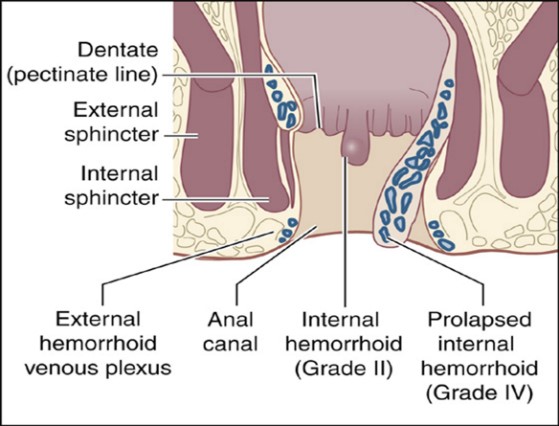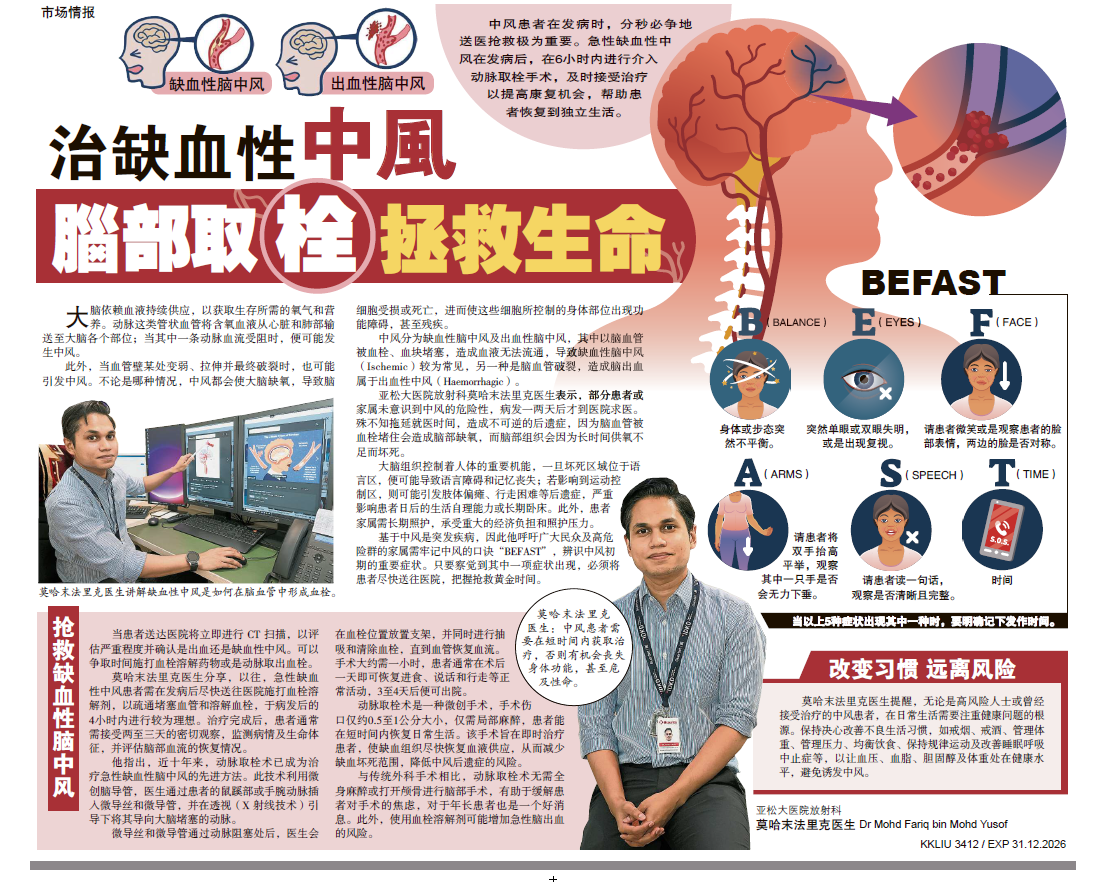Haemorrhoids are plexus of veins in the anal canal. These are also called Anal Cushions. Those situated above the dentate line are internal haemorrhoids and those below are called external haemorrhoids

Internal haemorrhoids
The submucosal plexus of veins above the dentate line form the internal haemorrhoids (common sites are the 3, 7, and 11 o’clock positions). The internal haemorrhoids commonly present as painless per rectal bleeding. They can later proplase (they can be seen or felt at the anus). Diagnosis is by proctoscopy (passing or small lubricated tube up the anus).
Table below shows the classifications of internal haemorrhoids and the common treatment options:
|
Classification |
Diagram & Picture |
Treatment options |
|
1st degree |
|
|
|
2nd degree |
|
|
|
3rd degree |
|
|
|
4th degree |
|
|
External haemorrhoids
External haemorrhoids occur when the veins in the subcutaneous area of the anal canal enlarge and later get thrombosed (clot).
External haemorrhoids can be treated conservatively with analgesics, Flavoroids, stool softeners, sitz baths and high fibre diet. In cases where it is very painful, surgery can be done under anesthesia – incise and express out the thrombus. The wound will heal spontaneously.
Symptoms of Haemorrhoids
- Painless bleeding
- Itching or irritation
- Pain or discomfort
- Protruding from the anus
- Swelling around the anus
- Painful lumps near the anus
- Leakage of feces
Causes of Haemorrhoids
- Diet- low fiber
- Constipation
- Persistent diarrhea
- Pregnancy
- Ageing
- Lifting heavy object
Conservative management
You have been prescribed a treatment by your doctor to stop the symptoms of your haemorrhoidal disease (pain, bleeding, anal discharge, itching). Some factors seem to provoke their appearance. Below are 10 simple tips to follow in order to avoid these symptoms and thus contribute to the improvement of haemorrhoidal disease:
- Drink lots of water (at least 1.5 litres to 2 litres per day).
- Avoid food which could cause local irritation (spicy food, alcohol) or bowel excitation (coffee, tea).
- Eat a balanced diet (food rich in fibers, cereal, bran bread, fruit, and vegetables).
- Look after local personal hygiene, but beware of products which may become a source of irritation in the long run.
- Take a regular exercise, such as gymnastics, walking, or swimming. Avoid certain sports such as cycling and horse-riding.
- Try to avoid lifting heavy weights.
- Use the toilet at a fixed time (eg: when you wake up or after drinking a big glass of water).
- Avoid wearing tight clothes.
- Do not stay in hot places for too long.
- Consult your doctor when symptoms persist (eg: blood on toilet tissue or anal discomfort).
Laser Treatment
The laser treatment is suitable for patients with haemorrhoids from stages 2 to 4 under appropriate anesthesia. The energy of the laser is inserted centrally through a radial emitting laser fiber into the haemorrhoidal plexus. Controlled laser energy deposition obliterates the nodes from inside.
No tissue is cut off, compared to conventional surgery. Minimally invasive laser haemorrhoids procedure method protects the sphincter muscle. This results in only a very small wound, which will heal completely shortly after the surgery.
Effects of the laser treatment
The controlled laser energy cuts off blood supply to the enlarged haemorrhoids. Bleeding ceases within a few days after the laser treatment. The haemorrhoids will also start to shrink.
Advantages of the laser treatment
- Minimal or no pain, compared to other treatment options.
- Fast recovery.
- No open wounds.
- Patient can expect to pass motion soon after surgery, and usually without pain.
- Accurate tissue reduction in the haemorrhoid nodes.
- Maximum preservation of continence.
- Best possible preservation of sphincter muscle and related structures such as anoderm and mucous membranes.
Suggestive Post-Op Regime
- Immediately post-op, you could expect to be up and about and discharged after 1 night stay in the hospital. The procedure can be performed as a Day-care procedure as well.
- You could expect to pass gas and pass motion normally after the procedure.
- Post-op swelling is always expected due to the heat generated by laser from inside the haemorrhoid. Swelling is usually painless and will subside after a few days. To reduce swelling, you might be given medication, or Sitz-bath (to do it as per instructions by the doctor/nurse.
- Once swelling subsides, shrinkage of the haemorrhoid will start and may take up to 6 weeks to fully shrink.
- Take all medicines as per prescribe by doctor.
- Rest at home and minimize daily activities as much as possible.
- Drink lots of water, go on a diet with lots of fiber, vegetable and fruits.
- Do not do any straining activity or exercise within the first 2 weeks after the procedure.
- Within the first 1-2 weeks, slight bleeding and mucus discharge can occur which is normal. Please contact your doctor immediately if you encounter any abnormality.















